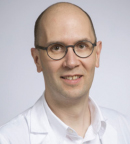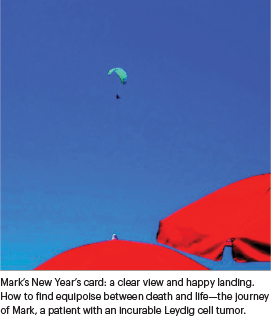In the summer of 2017, while visiting Normandy, 64-year-old Mark’s right testis became enlarged and tender. His initial workup identified a large testicular Leydig cell tumor with adverse pathologic features; computed tomography showed no evidence of metastasis.1,2 His medical history was otherwise significant for coronary artery disease and mild to moderate depression.
Mark, who had grown up in the Dutch port city of Rotterdam, was intimately familiar with the sea; after his diagnosis, he often used a logbook to record his thoughts and emotions and linked these to metaphors of seafaring. As this narrative will show, treatment was challenging because, in Mark’s words, “the course was often unknown, the nautical charts scarce, and the log entries sketchy.” Ultimately, this uncertainty fostered a dual awareness of life and death that helped Mark skillfully navigate difficult waters while teaching us, his treating oncologist, and the palliative care specialist, who was introduced at diagnosis of advanced disease, new ways to engage with patients. Toward the end of his life, Mark gave us a copy of his logbook and agreed to share his story.

Aurelius G. Omlin, MD

Karen Nestor, MD
Treatment Course for Rare Tumor
Leydig tumors are a rare entity of testicular tumor. Treatment options for metastatic disease are limited; in most cases, standard chemotherapy and other systemic treatments show little antitumor activity.3
We first met Mark at our joint urology-oncology clinic, where he came to discuss the option of retroperitoneal lymph node dissection (RPLND). We explained that experts had conflicting recommendations about the utility of RPLND in this setting, emphasizing we could not predetermine whether the surgery was necessary but that it might be Mark’s only curative option if he did turn out to have nodal metastases. Even after talking with his family and cancer specialists, Mark felt torn, frustrated by the need for “a binary answer, operation yes or no, with no leverage for anything in between the two options.”
Ultimately, he opted for RPLND; to everyone’s surprise, pathology showed limited nodal metastases with extracapsular extension. As physicians, we were relieved to have recommended surgery—Mark’s disease was more extensive than imaging had suggested. Mark, however, was distraught: “I panicked; all sorts of scenarios came to my mind. My first thought was to leave the hospital as soon as possible. I only wanted to go home and have time to think.”
After consulting with our institution’s department of integrative medicine, he decided to travel to Scuol, in the mountainous region of Switzerland, to receive inpatient rehabilitation at a clinic that focuses on integrative oncologic care. While there, Mark developed chylous ascites (a postoperative complication of extended lymph node dissection) requiring paracentesis. On ultrasound, new suspicious lesions were noted in his liver.
“Dark shadows and clouds started to appear,” he wrote. “After 1 week, I was transferred back to the main hospital for another ultrasound and liver biopsy—paradise lost! I felt a depression coming on, and questions started to appear—what is the sense of all of this? I lost my optimism and structured way of thinking.”
Biopsy identified hepatic metastases, which dramatically altered his diagnosis from localized, potentially curable disease to advanced cancer. Palliative care would play an important role now as options for systemic antitumor treatment were limited.
Preparing for Death
At this point, Mark believed that death was imminent. His physicians had been upfront about his poor prognosis, and he responded by living very much in the present, asking himself: “What do I absolutely need to finish before I die, and how shall I live during the time that I have left?” His life, he wrote, had been “happy and fulfilled, and if it is time to go, so be it.” He decided to plan his funeral and finalize his will: “I tried to focus on important things and set unimportant things aside. I was very lucid and focused, and I surprised myself with my ability to cope.” This is an example of “middle knowledge,” a coping strategy in which patients or caregivers acknowledge and even prepare for death while at the same time denying they are in mortal danger.4 Such denial can help individuals manage profound anxiety about dying or losing a loved one.
Even as Mark prepared for death, he opted for additional treatments aimed at slowing disease progression. Checkpoint inhibitor therapy (based on high focal programmed cell death protein 1 ligand expression) was ineffective, but selective internal radiation therapy stabilized his liver metastases and sparked a feeling of dazed reprieve: “I was euphoric, but also confused: I had expected my life to end in the very near future. It took some time before I felt on track again. After that, I increasingly felt that a weight had been lifted. I felt a bit more alive.”
About 8 months later, he developed painful bone metastases. His logbook at this time reflected his anxiety: “How to continue now? Is this the moment where life will end?” Palliative radiation therapy improved his bone pain, and palbociclib5,6 stabilized his cancer. Paradoxically, his depression grew.
Mark wrote: “I had believed and accepted that I was going to die very soon. Therefore, the fact that treatment temporarily had stopped the cancer did not lead to any feelings of happiness. I felt like I was in a vacuum. The time ‘given’ to me felt boring, like a heavy weight. I had no more unfinished business. I felt I was walking a tightrope between life and death. At times I almost longed for death. I felt deflated.”
Mark’s existential crisis on learning that his cancer was metastatic is understandable, but why the second crisis when treatment temporarily controlled his disease? Furthermore, how do we, as oncologists, respond when we achieve an unexpectedly positive treatment response that triggers such a crisis for our patients? Can we sufficiently understand and empathize with their suffering, or do we simply react (“your treatment is currently working—I’m not sure why you are upset”)? Do we even, perhaps, feel hurt, as if our patients’ dismay means they do not appreciate our efforts?
Our accumulated experience at work and in life has shown us that for patients with serious illnesses, it sometimes is easier to expect the worse than be torn between hope and despair. Ironically, however, advances in cancer treatment have created just such a conundrum—prognostication has become increasingly challenging for oncologists and patients, who may experience multiple instances of disease progression and remission, living longer but with less certainty and no hope for a cure. This could create an emotional roller coaster for anyone, even a maelstrom: Having resigned ourselves to death, how can we find the strength to again turn toward life? In addition, how can the clinician-patient relationship help pave the way for living?
Studies indicate that a patient’s awareness of the end of life is not fixed, but nuanced, reflecting various states of consciousness and repression that can alternate, fluctuate, or even coexist. Indeed, mental health can be seen as the capacity to sustain and tolerate these shifts among incongruent self-states, feelings, and revelations sparked by unconscious sources.7 Such insights match our own observation that patients can be fully aware of their impending death while simultaneously possessing a strong will to live—one that is characterized by intense sensory experiences. This state can be seen as “walking a tightrope between life and death,” a phenomenon that some scholars call “double awareness.”8
Like middle knowledge, double awareness can help individuals navigate an essential human conflict—the need to engage with the world while also preparing for death. For patients with advanced cancer, double awareness can foster an inner balance, an equilibrium between being aware of the process of dying and being committed to living fully. The concept of double awareness upends the traditional paradigm in which patients are expected to progressively overcome their fear of death—often with the aid of therapeutic relationships—and instead represents a state of uneasy, even dialectic tension that, to a lesser extent, characterizes all human existence.
Building a Trusting Rapport
Double awareness and middle knowledge suggest that in times of existential crisis, compassionately “holding space” for patients to find their own way may be more appropriate and helpful than telling them how to feel. Indeed, research indicates that even when there is no possibility of a medical or surgical cure, patients derive new hope and positivity from a clinician’s willingness to stay in the course with them, to hold out.9 For example, the early integration of palliative care and close collaboration with the treating oncology team can substantially reduce patient and caregiver stress, improve quality of life, and enhance understanding of illness and prognosis.10 In the case of Mark, the treating oncologist (AGO) introduced the palliative care specialist (KN) very early in the disease course.
Attachment theory also suggests that individuals with serious illnesses need clinician-patient relationships in which they are neither rejected nor overwhelmed with unwanted or unqualified care.11 Mark’s story exemplifies this process. His journey and its pace were very much self-determined, and he remained highly engaged in therapeutic decisions throughout the treatment. Such intensive shared decision-making took time and patience, but it paid off—he built a trusting rapport with us, knowing that even at emotionally fraught junctures, he could count on us and express himself authentically. In his own words, his treating physicians became “companions during the last stage of life.”
At times during his journey, Mark seemed irritable and weary, reiterating questions and finding no solace in repeated explanations. Because of our strong connection and the open nature of our conversations, we were able to ask him directly: “You seem irritable. What has happened? What do you need right now to make the most of the time you have left?” Mark ultimately expressed relief that we had seen and named his emotions and inner struggle, rather than simply continuing to discuss medical procedures. He described feeling “blocked—the time I have left has become a burden.” He also worried that his friends and family would see the upcoming Christmas as his last, and enduring their grief felt like too much.

Our direct honest conversations helped Mark find a way out of crisis. A short time later, he asked if we would support another course of rehabilitation in Scuol, where he hoped to reconnect with his creativity and plan the last part of his life. We agreed, and he described his return there as a homecoming, particularly because he was able to work with the same clinicians as before. Integrative oncologic care restored his equilibrium: “Psychiatric support motivated me to participate in life again, and the loving care I received from therapists and the road map I developed with them helped me accept both my physical reality and the psychological vacuum triggered by the feeling that I had been given extra time. Above all, art therapy stimulated my creativity, giving it free rein.”
In His Own Words
During his rehabilitation, Mark wrote a poem in his logbook:
“The scent of the sea, the smell of the ship brings back memories.
The sail slack in the wind, no land in sight, too far away.
I won’t look at the map to see if I can still reach a port.”
Mark’s poem beautifully captures his commitment toward living in a state of stress and his capacity to connect with life even while preparing for death. He described this process as “learning to die.” A passionate photographer sent a New Year’s greeting card featuring a picture he took as part of art therapy during his rehabilitation in Scuol. It shows a paraglider with the caption: “We wish you a clear view and happy landing in the New Year.” Supportive relationships and experiences helped Mark chart a course through stormy waters and find inner balance. “Double awareness” helped him not only cope with the tension of living while preparing for imminent death but also engage during his time with the world.
Lessons Learned
Working with Mark enabled us to experience the strength and value of shared oncologic and palliative care. With insight, courage, and creativity, he showed us that an unexpected improvement during a serious illness can trigger confusion and a sense of derailment, which may be eased if patients feel seen and accepted by their clinicians. Learning about coping mechanisms such as double awareness and middle knowledge has helped us better understand and empathize with Mark, and with other patients, supporting their own resilience as they navigate difficult waters. His story reminds us that as clinicians, our task is not to lead patients along a “correct” linear psychologic path, but rather to support and affirm their ability to find equipoise between death and life.12
ACKNOWLEDGMENT: We would like to thank Mark for his critical thinking, for challenging and teaching us news ways to engage with death and life, and for trusting us to help him navigate difficult waters. We also express a special thank you to Dr. Amy Karon for editorial assistance with this article.
This article was original published in the Journal of Clinical Oncology, March 2022. © 2022 American Society of Clinical Oncology. All rights reserved. At the time, At the time of publication, Dr. Omlin and Dr. Nestor were working in the Department of Oncology and Hematology at the Cantonal Hospital St. Gallen, Switzerland.
DISCLOSURE: The authors reported no conflicts of interest.
REFERENCES
1. Silberstein JL, et al: Clinical outcomes of local and metastatic testicular sex cord–stromal tumors. J Urol 192:415-419, 2014.
2. Nicolai N, et al: Clinical outcome in testicular sex cord stromal tumors. Urology 85:402-406, 2015.
3. Fankhauser CD, et al: Risk factors and treatment outcomes of 1,375 patients with testicular Leydig cell tumors: Analysis of published case series data. J Urol 203:949-956, 2020.
4. Weisman AD: On Dying and Denying: A Psychiatric Study of Terminality. New York, NY; Behavioral Publications; 1972.
5. Vaughn DJ, et al: Phase 2 trial of the cyclin-dependent kinase 4/6 inhibitor palbociclib in patients with retinoblastoma protein-expressing germ cell tumors. Cancer 121:1463-1468, 2015.
6. Necchi A, et al: Genomic features of metastatic testicular sex cord stromal tumors. Eur Urol Focus 5:748-755, 2019.
7. Mitchell SA: The treatment of choice: Commentary on paper by Susan Fairfield. Psychoanal Dialogues 11:283-291, 2001.
8. Rodin G, Zimmermann C: Psychoanalytic reflections on mortality: A reconsideration. J Am Acad Psychoanal Dyn Psychiatry 36:181-196, 2008.
9. Meerwein F: Das ärztliche Gespräch—Grundlagen und Anwendungen. Berne, Switzerland; Verlag Hans Huber; 1986.
10. Greer JA, et al: Understanding and addressing the role of coping in palliative care for patients with advanced cancer. J Clin Oncol 38:915-925, 2020.
11. Tan A, et al: Interpersonal processes in palliative care. Palliat Med 19:143-150, 2005.
12. Colosimo K, et al: ‘Double awareness’ in psychotherapy for patients living with advanced cancer. J Psychother Integr 28:125-140, 2018.

